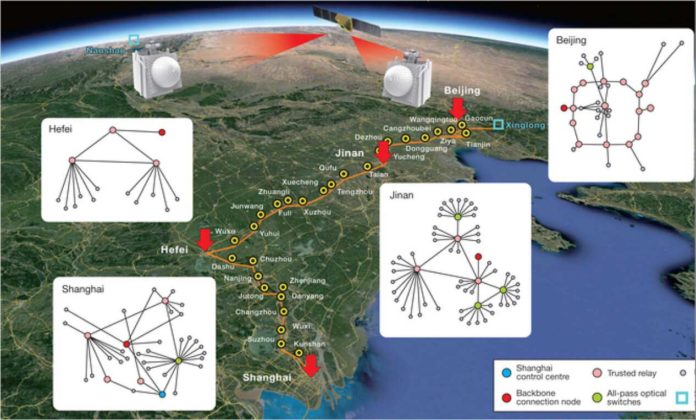Quantum communication is unhackable; hence it is the future of secure information transfer for banks, power grids, and other sectors. Quantum key distribution (QKD) is the heart of quantum communication.
QKD uses the quantum states of particles—e.g., photons—to form a string of zeros and ones, while any eavesdropping between the sender and the receiver will change this string or key and be noticed immediately.
The most common QKD technology uses optical fibers for transmissions over several hundred kilometers, with high stability but considerable channel loss. Another major QKD technology uses the free space between satellites and ground stations for thousand-kilometer-level transmissions.
Recently, Chinese scientists have established the world’s first integrated quantum communication network, combining over 700 optical fibers on the ground with two ground-to-satellite links to achieve quantum key distribution over a total distance of 4,600 kilometers for users across the country.
In 2016, China launched the world’s first quantum communication satellite (QUESS, or Mozi/Micius) and achieved QKD with two ground stations, 2,600 km apart. In 2017, an over 2,000-km long optical fiber network was completed for QKD between Beijing and Shanghai.
Using relays, the ground-based fiber network and the satellite-to-ground links were coordinated to serve in excess of 150 industrial users across China, including state and local banks, municipal power grids, and e-government sites.
Jianwei Pan, Professor of USTC, said, “Our work shows that quantum communication technology is sufficiently mature for large-scale practical applications. Similarly, a global quantum communication network can be established if national quantum networks from different countries are combined, and if universities, institutions, and companies come together to standardize related protocols, hardware, etc.”
In recent years, scientists tested and improved the performance of different parts of the integrated network. For instance, with an increased clock rate and more efficient QKD protocol, the satellite-to-ground QKD now has an average key generation rate of 47.8 kilobits per second, 40 times higher than the previous rate.
In the future, scientists are planning to expand the network in China and with their international partners from Austria, Italy, Russia, and Canada. They also aim to develop small-scale, cost-efficient QKD satellites and ground-based receivers and medium and high earth orbit satellites to achieve all-time, ten-thousand-km-level QKD.
Journal Reference:
- An integrated space-to-ground quantum communication network over 4,600 kilometers, Nature (2021). DOI: 10.1038/s41586-020-03093-8
